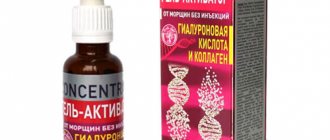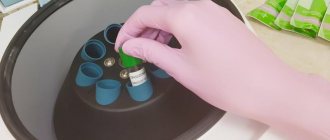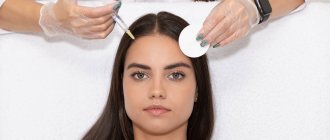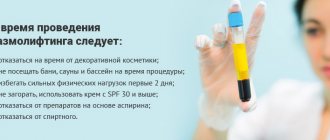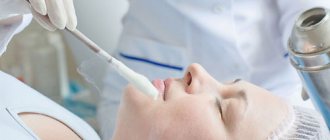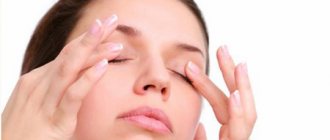Plasmolifting (PRP, Plateletrichplasma) is an injection method of subcutaneous administration of platelet-rich plasma from the patient’s own blood, leading to the activation of regenerative processes in the skin. Human blood plasma contains the substances fibrin and collagen. They are the ones who participate in the construction of new tissue cells in the body. These substances help restore cells of any organ, be it skin that has lost its elasticity or brittle hair. The essence of the method is to isolate plasma from human blood and then inject it into the area requiring restoration.
In addition, plasma has a high concentration of platelets, which contain special growth factors and proteins. They stimulate the production of fibroblasts in stem cells, which enhances the regeneration process.
Mechanism of action of plasma lifting
To use this method of cell regeneration, platelet autoplasma (TAP) is required. It does not contain red blood cells, and the number of platelets in it is close to their number in peripheral blood (150-350 thousand/μl). Such plasma is very rich in amino acids, mineral elements (potassium, magnesium, zinc, iron, calcium, etc., peptides and vitamins B, C, A, D, E, K, necessary for the life of cells. Being a natural component of the human body , autoplasma does not cause allergic reactions. This method is also universal due to its bioavailability, due to which regeneration processes occur naturally.
Physiologically, the process of plasmolifting occurs as follows: when platelets lose contact with the endothelium, leaving the capillaries and vessels, they change their shape and secrete alpha granules, which saturate the damaged area with growth factors.
The same thing happens in the plasmolifting procedure, when autoplasma is injected into the desired area, i.e. platelet adhesion and the release of growth factors from alpha granules occur, as in a normal protective physiological process.
The essence of technology
The procedure is quite simple in the technique of its implementation.
The material is injected under the skin into problem areas. However, the preparation process takes a lot of time and requires effort from both the specialist and the patient. It is believed that plasma lifting is contraindicated during lactation or pregnancy . Like other methods that involve interfering with physiological processes.
However, after the procedure, skin fibroblasts begin to actively synthesize collagen, elastin and hyaluronic acid. These substances provide an optimal balance of humidity, turgor and elasticity, which is important during rehabilitation procedures after various operations, injuries, as well as when bearing a child.
The advantage of plasma lifting over other methods is the use of our own material. It is absolutely safe and does not give any side effects.
Platelet-rich plasma can do more than just rejuvenate your face. It also helps fight hair loss, dental and other problems.
How does the plasma lifting procedure work?
Blood taken from the patient is subjected to a centrifugation procedure to separate red blood cells. Platelet autoplasma should be yellow. After 10-15 minutes, the prepared platelet autoplasma can already be used as an injection into the area required for treatment. Before this, the skin is treated with a special anesthetic cream. A thin needle is taken and the drug is injected using the papular method.
The course of treatment using plasma lifting is prescribed individually, based on the initial condition and degree of cell damage. On average, 3-4-5 procedures are recommended with an interval of about a week - such a course produces a noticeable effect. To maintain improved cell condition, you can repeat the procedure once every year or two.
Why not during pregnancy?
During the period of bearing a child, all biological processes change in a woman’s body. It is difficult to talk about the response to plasma therapy in this condition, since research in this area has not yet been conducted.
The restriction was introduced to prevent physiological changes and undesirable consequences. After all, any injections tone the muscles, which in itself is very dangerous during pregnancy.
Experts advise carrying out the procedure no earlier than 3-4 months after the end of breastfeeding. Do not neglect this recommendation.
Indications for plasma lifting
In cosmetology, the use of plasma lifting is advisable in the following cases:
- loss of skin elasticity, deterioration of its turgor;
- unwanted skin pigmentation;
- noticeable facial wrinkles, the appearance of age-related folds on the skin;
- sagging face, deterioration of facial oval;
- gray, “tired” complexion;
- post-acne and acne;
- scars and stretch marks on the skin;
- hair loss (alopecia) and deterioration of their condition.
Of course, the use of autoplasma in cosmetology is not limited only to the face and scalp; these reasons are only the main ones. The method is used on any part of the human body that has defects. Body plasma lifting is a popular procedure. It is used locally to treat cellulite and obesity and rejuvenate the skin of the body.
Recovery
In the first few hours, slight swelling and redness are noticeable on the skin, which completely disappear within 1-2 days. To ensure that rehabilitation goes quickly and without complications, use the following recommendations:
- do not touch the treatment area with your hands, do not scratch or rub;
- do not use decorative cosmetics for 2-3 days;
- limit visits to the sauna and swimming pool for 10-14 days;
- Avoid exposure to the sun and tanning in a solarium (put on sunglasses before going outside).
During the rehabilitation period, it is important not to forget about the wound healing agents prescribed by the cosmetologist and use them regularly.
Contraindications for plasma lifting
Despite the maximum naturalness of this method and the greatest proximity of autoplasma to the components of the blood of a certain person, the cosmetic procedure of plasma lifting has a certain number of contraindications. Among them are:
- Purulent-infectious skin diseases;
- Diabetes;
- Bleeding disorders and blood diseases;
- Decreased immunity;
- Oncology;
- Hepatitis;
- Diseases of the kidneys and pancreas.
At the same time, plasma lifting has a minimal risk of complications and side effects, because with this method no foreign substances are introduced into the body. This is its main difference from biorevitalization and mesotherapy procedures.
The individual effect of using this method is due to the dependence on the initial state of the cells. Plasmolifting is attractive primarily for its simplicity and naturalness, as well as the minimal risk of side effects. The skin is not injured. What is better biorevitalization. mesotherapy or plasma lifting for each specific patient can only be determined by a cosmetologist.
Let's summarize
Plasmolifting involves intervention in the biological processes of the body. Therefore, it is not recommended to do the procedure during pregnancy.
If you are at the planning stage of pregnancy and have dental or gynecological problems, it’s time to sign up for plasma therapy. Using this method, you can not only recover from a number of diseases, but also restore the natural beauty of your skin and hair.
Be careful when choosing a clinic. It is important that the specialists working in it have not only solid professional experience, but also a license to carry out such medical procedures.
Author: Elvira Poltaranina
The effect of plasma lifting
Most patients notice a noticeable positive effect after 1-1.5 weeks. Some note that the effectiveness of plasma lifting occurs after the first injection. The result depends on age, skin condition and characteristics of the body as a whole.
Among those who have tried the plasmolifting method on themselves, the majority leave good reviews about the procedure, which will help shape the attitude towards this method in new patients. Many women note that the result of the procedure is skin rejuvenation, a fresher appearance, gradual smoothing of scars and a reduction in the effects of acne. The skin becomes more elastic and tightened.
Some patients complain of swelling and bruising on the skin after using an autoplasma injection, but in fact this is an obvious consequence of the cosmetic procedure. Side effects from plasma lifting are extremely rare and are usually associated with a violation of the procedure protocol or a violation of the rules of asepsis and antisepsis. Some are confused by the fact that for a noticeable effect, not one, but a certain number of injections are required, and the cost of such a procedure may not be affordable for everyone.
The plasmolifting technique has: A rejuvenating effect.
Helps remove dead cells, promoting the formation of new ones, smoothes the skin, increasing its turgor, the skin becomes tender and soft to the touch. Activates the BCL-2 gene, which delays cell aging.
Protective effect.
Strengthens the protective barrier against the effects of harmful ultraviolet radiation, improves skin regeneration, due to which small wounds and scars heal faster. The skin becomes protected from the effects of all kinds of external factors that have a negative impact on its condition: temperature changes, sunlight, the consequences of taking strong medications. Suppresses the proliferation of pathogenic microflora.
Moisturizing effect.
Prevents skin dehydration. The skin is deeply hydrated and the synthesis of macromolecular proteins, which provide skin elasticity, is improved. Skin cells retain more moisture inside, which eliminates the feeling of tightness, dryness, and reduces the appearance of skin irritation and inflammation.
Reduces skin photosensitivity.
The appearance improves due to increased cell metabolism, which prevents the appearance of age spots after sun exposure, which leads to an even complexion.
Improves skin trophism.
The process of blood circulation in the dermis is enhanced, metabolic processes are accelerated, which leads to cell renewal, the skin takes on a healthy and fresh appearance.
Lifting effect. Skin cells are renewed and saturated with moisture, the oval of the face is tightened. Fights hyperpigmentation. The stratum corneum is exfoliated, skin cells are renewed, and facial tone is evened out.
Plasmolifting: before and after photos
Plasmolifting of the face
Plasmolifting for pigmentation
Plasmolifting for acne and post-acne
Plasmolifting for hair
Plasmolifting of the body
Plasmolifting of the abdomen
Plasmolifting of the breast
We recommend reading:
- Plasmolifting and orthoplasma
- Treatment of joints with blood plasma
- Autoplasmotherapy of joints
- Tests for plasma lifting
- Plasmolifting for immunity
- Plasmolifting in orthopedics and traumatology
- Plasmolifting of joints
- Plasmolifting of the knee joint
- Plasmolifting for arthrosis
- Plasmolifting for coxarthrosis
- Plasmolifting restrictions
- Plasmolifting for arthritis
- Plasmolifting for osteochondrosis
- Plasmolifting of the hip joint
More articles →
